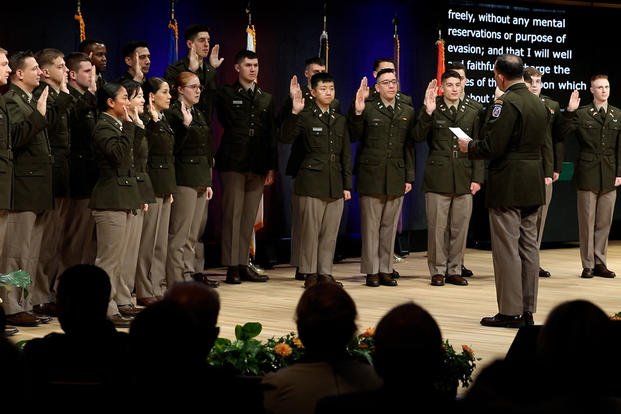The Army is undertaking a major shake-up of its Reserve Officers’ Training Corps footprint, shutting down or reorganizing programs at 84 college campuses. The move, which Army planners describe as surgical, is part of a broader push to trim down bloat in the service.
In total, 291 students are expected to be affected, most of them having to potentially shift to programs at other nearby campuses. Of those, 16 contracted cadets will have their programs totally deactivated and be left with few alternatives, though in some cases the service is aiming not to disrupt their tenures. Those cadets will be given the choice to transfer to another ROTC program or exit their contracts without penalty. Seniors currently in the program won’t see changes, as the cuts won’t kick in until after graduation. Most first- and second-year students haven’t yet signed binding service contracts.
The ROTC program is among the most public-facing elements of the Army. In September, Military.com reported that the service was eyeing a roughly $100 million cut to ROTC throughout the rest of the decade. The move comes as the service is aiming to nip and tuck where it can as part of a larger reorganization effort, which includes dismantling much of the Army Reserve’s aviation elements and deactivating all but two Security Force Assistance Brigades.
Read Next: Constraints on Trump’s War Powers Rejected by Senate After Iran Strikes
“This rebalance and optimization effort ensures we meet the Army’s requirements for officer commissioning while being good stewards of resources,” Brig. Gen. Maurice Barnett, commanding general of U.S. Army Cadet Command, said in a statement to Military.com. “We are working closely with our workforce, cadets and academic partners to ensure a smooth transition while preserving the quality of our ROTC programs.”
ROTC’s commissioning capacity is expected to shrink by about 500 slots, though the max capacity was nowhere close to being reached, with some campuses underperforming and no need from the force to recruit that many officers. The service has actually overrecruited officers in certain fields in recent years. After the shifts, ROTC will be able to produce roughly 5,500 officers annually, even as the service’s demand has hovered closer to 5,000 in recent years.
Service officials familiar with the plans described it being easier, and more cost effective, to shut down a program delivering only 10 officers per year and, if needed, widening the spigot at bigger schools, like Ohio State University or the University of Florida, two of the top 20 ROTC schools, which account for 20% of all officers commissioned through the program.
The Army emphasized that first- and second-year cadets, who typically have not yet committed to military service through formal contracts, will have opportunities to continue their training at nearby partner institutions or walk away from the contracts without any financial obligations.
Here are the host ROTC programs being shut down:
- California Polytechnic State University — San Luis Obispo (Calif.)
- University of Northern Iowa (Iowa)
- Western Illinois University (Ill.)
- Truman State University (Mo.)
- Elizabeth City State University (N.C.)
- Saint Augustine’s University (N.C.)
- Clarkson University (N.Y.)
- John Carroll University (Ohio)
- University of Wisconsin-Oshkosh (Wis.)
- West Virginia State University (W.Va.)
Additionally, these schools that allow students at one campus to attend the ROTC program at another will lose their affiliation with the program:
- University of California — Merced (Calif.)
- Buena Vista University (Iowa)
- University of Dubuque (Iowa)
- Idaho State University (Idaho)
- University of Nebraska — Kearney (Neb.)
- Millersville University (Pa.)
- Pennsylvania Western University — Clarion (Pa.)
- Texas A&M International University (Texas)
- St. Norbert College (Wis.)
The programs at dozens of other schools are being redesignated and reorganized. The full list is here.
Read Next: Upcharging on Food, Selling Booze: The Army’s Plan to Privatize Dining
Story Continues
Read the full article here

